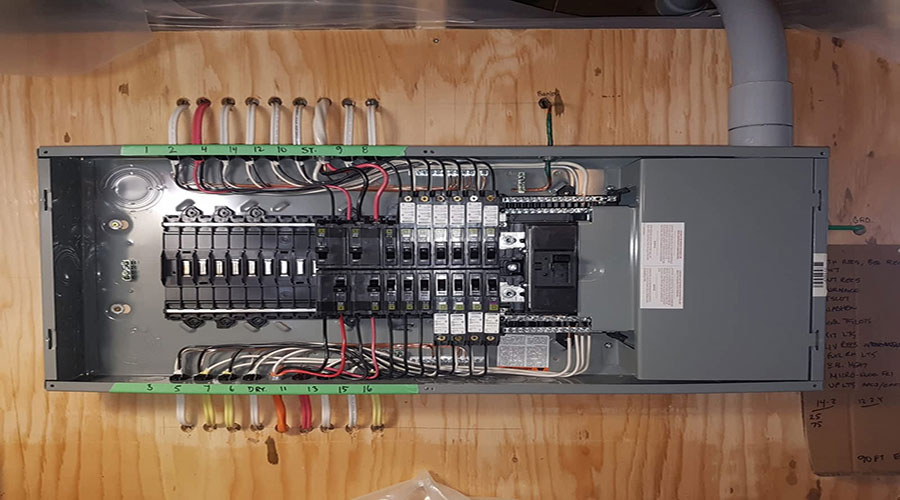
The first difference between electrical panels in the United States and Canada is that they are oriented differently. They are typically installed vertically in the US, while they are installed sideways in Canada. You may see this as insignificant, but it has significant implications for both safety and efficiency of electricity use.
According to the Canadian Electric Code (CEC), electrical panels are commonly sideways in Canada. The National Electric Code (NEC) in the US calls for the vertical positioning of electrical panels. There are some notable differences in the CEC and NEC guidelines.
Why are Electrical Panels Installed Sideways in Canada?
A common question from those who live in the US is why electrical panels are horizontal in the US but vertical in Canada. The problem with Canada (or the CEC) is that it follows NFPA 70, which does not include certain allowances. The NEC (National Electrical Code) is the US standard, and it does make allowances for different orientations. The CEC was updated in 2009 to be more like the NEC, but there are still some discrepancies.
The sideways installation is that Canada experiences more extreme weather conditions than the US. The panels are less likely to be damaged by snow or rain if installed horizontally. In fact, in some parts of Canada, it is required by law to have electrical panels installed this way due to the high potential for damage from severe weather.
Why are Electrical Panels Vertical in the US?
The difference in orientation of electrical panels: Canada vs. the United States has significant implications for both safety and efficiency.
The National Electrical Code (NEC) is the standard for safe electrical wiring and practices in the United States. The NEC mandates that circuit breaker panels be installed vertically, with the breaker’s handle pointing up to indicate that it is in the “on” position. The vertical orientation makes it easy for homeowners or technicians to see at a glance if the breaker is off or on.
240.33 Vertical Position.
Enclosures for overcurrent devices shall be mounted in a vertical position unless that is shown to be impracticable. Circuit breaker enclosures shall be permitted to be installed horizontally where the circuit breaker is installed in accordance with 240.81. Listed busway plug-in units shall be permitted to be mounted in orientations corresponding to the busway mounting position.
240.81 states
Circuit breakers shall clearly indicate whether they are in the open “off” or closed “on” position. Where circuit breaker handles are operated vertically rather than rotationally or horizontally, the “up” position of the handle shall be the “on” position.
Can an Electrical Panel be Mounted Sideways in the US?
electrical panels are only mounted sideways in Canada, not the US. The lone exception is if installing the electrical panel upright is not feasible, which would only likely occur in an older house where the breaker box placement is limited.
There are potential safety hazards involved with doing it this way, so contractors install most electrical panels in the US vertically. You may need to move the electrical panel to meet local electrical codes to do so.
The National Electric Code (NEC) says that electrical panels are installed vertically in the US. This code is a set of regulations covering all aspects of electrical wiring and installations in the United States. It is updated every three years, with the most recent update being in 2020.
There are many reasons why the NEC specifies vertical installation for electrical panels, some of which have been mentioned already (i.e., phase wire on the bottom, short circuit potential). Other reasons include the ease of wiring and quality control. When installing panels vertically, it is easier to ensure that everything has been done correctly with electrical installations in various buildings.
Many dead front covers have a retainer lip at the bottom to keep the cover from falling after removing the screws. If you install them horizontally, the retainer becomes useless, putting anyone who tries to take off the cover at risk of hurting themselves.
What is the OSHA Standard for Electrical Panels?
The Occupational Safety and Health Association (OSHA) is the government agency charged with enforcing regulations concerning occupational safety in all 50 states. They establish regulations, guidelines, and standards for workplace health and safety to hold employers accountable to specific baseline requirements.
Electrical panels must have a minimum of 3 feet (36 inches) of clearance and a minimum headroom of 6.5 feet, or the height of the equipment, whichever is greater, according to the Occupational Safety and Health Administration (OSHA) and the National Electrical Code (NEC).
One of their most important roles is setting electrical equipment design specifications, including wiring methods and installation of electrical panels. The OSHA standard for electrical equipment design states that you should install all equipment in a way that is consistent with the manufacturer’s recommendations to avoid safety hazards.
The National Electric Code (NEC) says that electrical panels are installed vertically in the US, which is the guideline OSHA uses.
In Conclusion
This article has been a great introduction to the differences between electrical panels in Canada and America. If you’d like more information on circuit breaker types, we have another blog post that discusses this topic at length. We hope you found it interesting!







